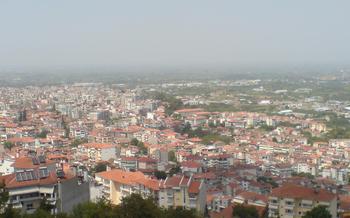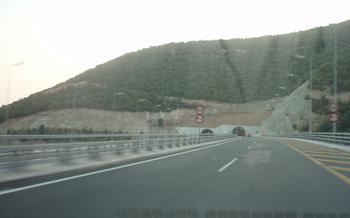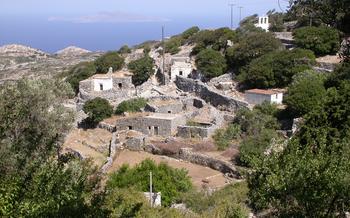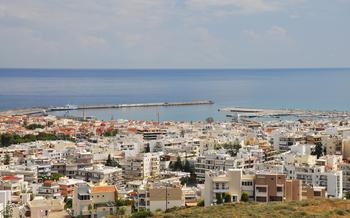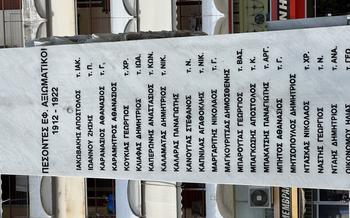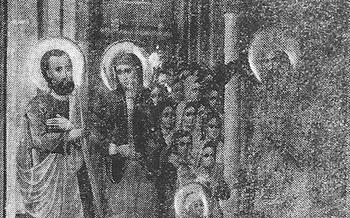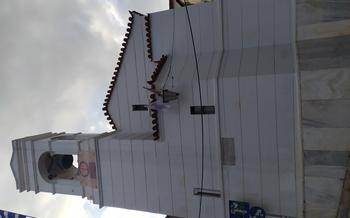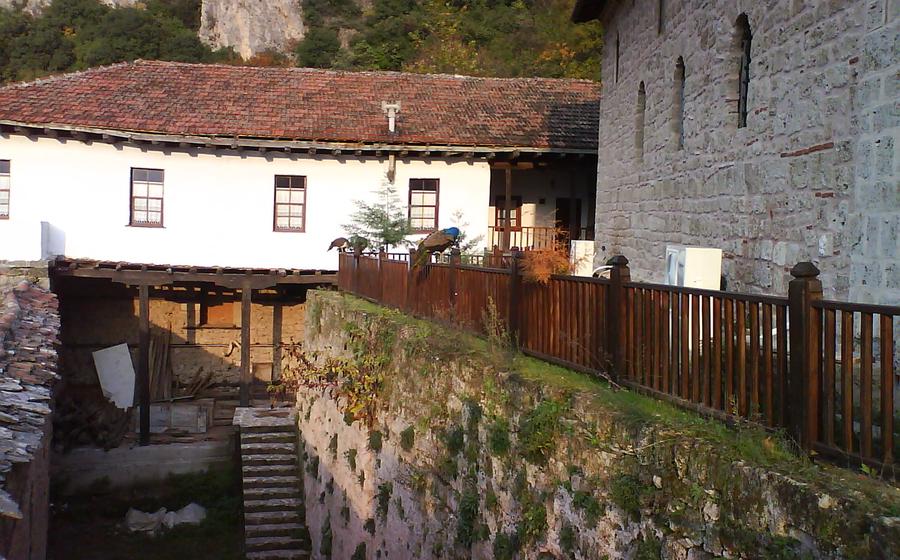
Saint John the Baptist Monastery
- Historical Significance
- Religious Importance
- Cultural Heritage
- Accommodation and Facilities
- Visiting Hours and Etiquette
- Guided Tours and Information
- Local Cuisine and Hospitality
- Events and Celebrations
- Pilgrimage and Spiritual Retreats
- Volunteering and Service
- Educational Programs and Workshops
- Souvenirs and Local Crafts
- Accessibility and Transportation
- Insider Tip
Historical Significance
The Saint John the Baptist Monastery, nestled in the heart of Veria, Greece, holds a rich and storied history that dates back to the 11th century. Founded by a pious monk named John, the monastery quickly rose to prominence as a leading religious and cultural center in the region. Throughout the centuries, it played a pivotal role in preserving Greek Orthodox traditions, promoting Byzantine art and culture, and influencing the spiritual and intellectual development of the surrounding communities.
The monastery's architectural style reflects the grandeur of its past. Its imposing stone walls, intricate carvings, and elegant arches showcase the artistry and craftsmanship of Byzantine and post-Byzantine eras. The centerpiece of the complex is the magnificent main church, adorned with stunning frescoes depicting scenes from the life of Saint John the Baptist and other biblical narratives.
Religious Importance
The Saint John the Baptist Monastery holds immense religious significance as a revered pilgrimage site for Orthodox Christians worldwide. Its reputation stems from its dedication to Saint John the Baptist, a pivotal figure in Christianity who baptized Jesus Christ and preached repentance. Pilgrims flock to the monastery to pay homage to the saint and seek spiritual guidance and blessings.
Daily rituals and religious ceremonies, including prayers, hymns, and processions, are conducted within the monastery's sacred spaces. These rituals are led by the resident monks, who devote their lives to serving God and upholding the monastery's spiritual traditions. The monastery also houses several notable religious relics and icons associated with Saint John the Baptist, which attract devout visitors seeking divine intervention and miracles.
Cultural Heritage
The Saint John the Baptist Monastery stands as a bastion of Greek Orthodox traditions, embodying the rich cultural heritage of the region. Within its hallowed walls, a treasure trove of artistic masterpieces awaits discovery. Icons of exquisite beauty, adorned with intricate gold leaf and vibrant hues, grace the monastery's chapels and corridors. Each icon tells a story, depicting scenes from the Bible or the lives of saints, inviting visitors to delve into the depths of Orthodox faith and spirituality.
Frescoes, with their vibrant colors and dynamic compositions, adorn the walls of the monastery church, creating a visual symphony that transports visitors to another era. These masterpieces depict biblical narratives, historical events, and the lives of saints, offering a glimpse into the rich tapestry of Byzantine art.
The monastery also houses a collection of ancient manuscripts, carefully preserved and meticulously handwritten. These precious texts, ranging from religious scriptures to historical chronicles, provide invaluable insights into the intellectual and spiritual pursuits of the monks throughout the centuries.
Beyond its artistic treasures, the monastery actively promotes Byzantine art and culture through various initiatives. Workshops and classes are conducted, where visitors can learn the techniques of iconography, Byzantine music, and other traditional crafts, fostering a deeper appreciation for the region's rich heritage. Cultural events, such as concerts, exhibitions, and lectures, are also organized, providing a platform for the exchange of ideas and the preservation of cultural traditions.
Accommodation and Facilities
For those seeking a deeper immersion into the monastic life, the Saint John the Baptist Monastery offers guesthouses or pilgrim accommodations within the monastery complex. These accommodations provide a simple and serene environment for visitors to rest and reflect. Basic amenities such as comfortable beds, shared bathrooms, and dining facilities are available to ensure a comfortable stay.
Overnight stays at the monastery are subject to availability and require prior reservations. Visitors are encouraged to contact the monastery directly to arrange their stay and make any necessary arrangements. Donations and voluntary contributions are welcomed as a way of supporting the monastery's ongoing operations and preserving its rich heritage.
Visiting Hours and Etiquette
The Saint John the Baptist Monastery welcomes visitors during specific hours, which may vary depending on the season. It is advisable to check the monastery's official website or contact them directly for the most up-to-date information. While visiting the monastery, visitors are expected to dress modestly and respectfully, covering their shoulders and knees. Proper attire contributes to the sacred atmosphere of the monastery and shows consideration for the religious community residing there.
Photography and the use of electronic devices are permitted within the monastery grounds, but visitors are kindly requested to be mindful of the privacy of the monks and other visitors. It is important to refrain from taking photographs during religious services or ceremonies and to respect the tranquillity of the environment. Visitors should always seek permission before photographing or recording any individuals or sacred objects within the monastery.
Guided Tours and Information
For those seeking a deeper understanding of the monastery's history, spirituality, and cultural significance, guided tours led by knowledgeable monks or staff members are available. These tours provide visitors with insights into the daily life of the monastic community, the architectural features of the complex, and the religious traditions practiced within its walls.
General overviews introduce visitors to the monastery's founding, its role in the region's history, and the veneration of Saint John the Baptist. Historical tours delve into the architectural evolution of the monastery, its past inhabitants, and the impact of major historical events. Spiritual explorations focus on the monastery's spiritual practices, the teachings of the Orthodox Church, and the significance of pilgrimage and contemplation.
To arrange a guided tour, visitors can contact the monastery in advance or inquire upon arrival. Donations are gratefully accepted to support the monastery's ongoing preservation and maintenance efforts. For those unable to participate in a guided tour, informative brochures and maps are available at the monastery entrance.
Local Cuisine and Hospitality
The Saint John the Baptist Monastery offers visitors a taste of traditional Greek cuisine, lovingly prepared with fresh, local ingredients. The monastery's dining facilities serve wholesome and delicious meals, often featuring dishes that have been passed down through generations of monks. Visitors can savor the flavors of hearty stews, freshly baked bread, and seasonal vegetables grown in the monastery's own gardens.
Beyond the culinary delights, the monastery extends a warm welcome to all visitors, embodying the spirit of Greek hospitality, or "filoxenia." The monks are known for their kindness and generosity, and they go out of their way to ensure that guests feel comfortable and well-cared for. Visitors are often invited to share meals with the monks, creating a sense of community and fostering meaningful interactions.
The monastery's hospitality extends beyond the dining table. Visitors have the opportunity to interact with the monks and learn about their daily lives, gaining insights into the spiritual and cultural traditions of the monastery. This exchange of experiences and stories creates a unique and enriching experience for both visitors and the monastic community.
The cultural traditions and customs surrounding food and hospitality in the region are deeply rooted in the values of sharing, generosity, and respect. Visitors to the Saint John the Baptist Monastery can immerse themselves in these traditions, savoring not only the delicious cuisine but also the warmth and hospitality of the monastic community.
Events and Celebrations
The Saint John the Baptist Monastery is not only a place of spiritual retreat but also a center of vibrant celebrations and events throughout the year. The annual feast day of Saint John the Baptist, celebrated on January 7th, is a major highlight. The monastery comes alive with special services, processions, and festivities that draw pilgrims and visitors from far and wide. During this time, the monastery is adorned with colorful decorations, and the air is filled with the sound of chanting and prayers. Visitors can witness traditional Greek dances, participate in processions carrying the relics of Saint John, and enjoy a festive atmosphere that showcases the rich cultural heritage of the region.
Other notable events include Easter celebrations, which are observed with great devotion and solemnity at the monastery. During Holy Week, visitors can experience the unique rituals and ceremonies leading up to Easter Sunday, including the reading of the Passion, the procession of the Epitaph, and the joyful celebration of the Resurrection. The monastery also hosts patron saint days dedicated to various saints throughout the year, each with its own unique traditions and celebrations. These events provide an opportunity for visitors to immerse themselves in the rich spiritual and cultural tapestry of the monastery and the surrounding community.
Pilgrimage and Spiritual Retreats
The Saint John the Baptist Monastery has long been a destination for pilgrims and spiritual seekers from around the world. The monastery's serene environment and rich spiritual traditions provide an ideal setting for prayer, meditation, and contemplation. Visitors are welcome to join the monks in their daily services, attend spiritual talks or workshops, or simply spend time in quiet reflection within the monastery grounds.
For those seeking a deeper spiritual experience, the monastery offers guided retreats and counseling sessions. The monks are available to provide guidance and support to pilgrims on their spiritual journey, helping them to explore their faith, deepen their connection with God, and find inner peace and transformation. Many visitors find their stay at the monastery to be a life-changing experience, leaving with a renewed sense of purpose and a stronger connection to their spiritual selves.
Volunteering and Service
The Saint John the Baptist Monastery welcomes visitors who wish to volunteer their time and skills to serve the community. Volunteering at the monastery is a rewarding experience that offers visitors the opportunity to give back, connect with the monastic community, and deepen their understanding of Orthodox Christian traditions.
Volunteers may assist with various tasks, such as maintenance and upkeep of the monastery grounds, gardening, hospitality duties, or helping with special events and celebrations. By volunteering, visitors can contribute to the preservation of this sacred site and participate in the daily life of the monastery.
To volunteer, visitors should contact the monastery in advance to inquire about opportunities and discuss their interests and skills. The monastery may have specific requirements or arrangements for volunteers, such as minimum age or length of stay. Volunteering at the Saint John the Baptist Monastery is a unique opportunity for visitors to immerse themselves in the spiritual and cultural heritage of Greece while making a meaningful contribution to the community.
Educational Programs and Workshops
The Saint John the Baptist Monastery is not only a place of worship and pilgrimage but also a center of learning and cultural preservation. The monastery offers a variety of educational programs and workshops that provide visitors with the opportunity to immerse themselves in Greek Orthodox traditions and Byzantine art and culture.
Iconography workshops are a highlight for those interested in learning the ancient art of icon painting. Under the guidance of experienced monks, participants can create their icons using traditional techniques and materials. Byzantine music workshops introduce visitors to the unique sounds and rhythms of Orthodox liturgical music. Participants learn to chant hymns and explore the rich history of this musical tradition.
For those seeking a deeper understanding of the Greek language and culture, the monastery offers Greek language classes. These classes are designed for all levels, from beginners to advanced learners, and provide an immersive experience in the language and culture of Greece.
The monastery's educational programs and workshops are open to visitors of all faiths and backgrounds. They offer a unique opportunity to learn about and appreciate the rich cultural heritage of the Greek Orthodox Church and to gain a deeper understanding of the monastery's role in preserving and promoting this heritage.
Souvenirs and Local Crafts
The Saint John the Baptist Monastery offers a unique opportunity for visitors to purchase souvenirs and locally made crafts that hold cultural and historical significance. These items, often handcrafted by the monks themselves or by skilled artisans from the region, serve as a way to support the monastery and preserve traditional craftsmanship.
Among the popular souvenirs, visitors can find intricate icons depicting Saint John the Baptist and other religious figures, carefully crafted using traditional techniques passed down through generations. These icons are not only beautiful works of art but also serve as a reminder of the monastery's rich religious heritage.
Handwoven textiles, such as rugs, scarves, and tablecloths, are another popular choice. These textiles showcase the region's vibrant colors and intricate designs, often inspired by Byzantine motifs. Each piece is unique, reflecting the skill and creativity of the local artisans.
Visitors can also find ceramic ware, pottery, and other decorative items that reflect the region's artistic traditions. These items are often adorned with intricate patterns and motifs, making them beautiful keepsakes to remember one's visit to the monastery.
By purchasing these souvenirs, visitors not only take a piece of the monastery's heritage home with them but also contribute to the preservation of traditional craftsmanship and the support of the local community.
Accessibility and Transportation
Reaching the Saint John the Baptist Monastery is a convenient and accessible journey. Whether you prefer public transportation or private means, various options are available to suit your needs.
For those relying on public transport, regular bus services connect major cities and nearby towns to Veria, where you can easily transfer to a local bus that takes you directly to the monastery. The bus stop is conveniently located just a short walk from the monastery entrance.
If you prefer the flexibility of driving, the monastery is easily accessible by car. The roads leading to the monastery are well-maintained and offer scenic views of the surrounding countryside. Ample parking space is available for visitors, ensuring a hassle-free arrival.
For visitors with disabilities or limited mobility, the monastery has made commendable efforts to ensure accessibility. The paths leading to the main church and other important areas within the complex are wheelchair-accessible, allowing everyone to enjoy the monastery's wonders without hindrance.
It's important to plan your transportation in advance, especially during peak tourist season or religious holidays when there may be an influx of visitors. This will ensure a smooth and stress-free journey to the Saint John the Baptist Monastery.
Insider Tip
As an insider tip, I highly recommend visiting the Saint John the Baptist Monastery during the early morning hours, before the crowds arrive. This is the perfect time to experience the serene atmosphere and tranquility of the monastery, without the hustle and bustle of many visitors. You'll have the chance to wander through the peaceful gardens, admire the intricate architecture, and soak in the spiritual energy of this sacred place. Additionally, the morning light casts a magical glow on the monastery, creating stunning photo opportunities for capturing the beauty of this hidden gem.
